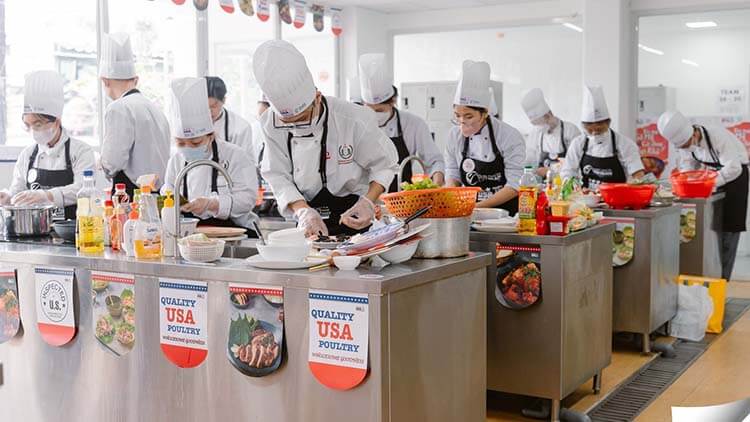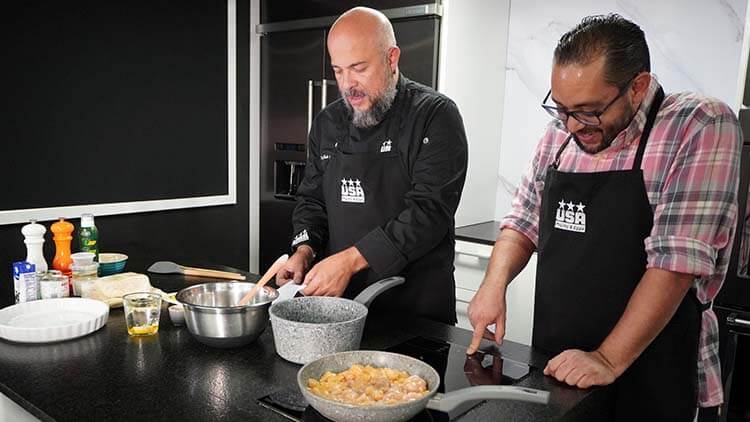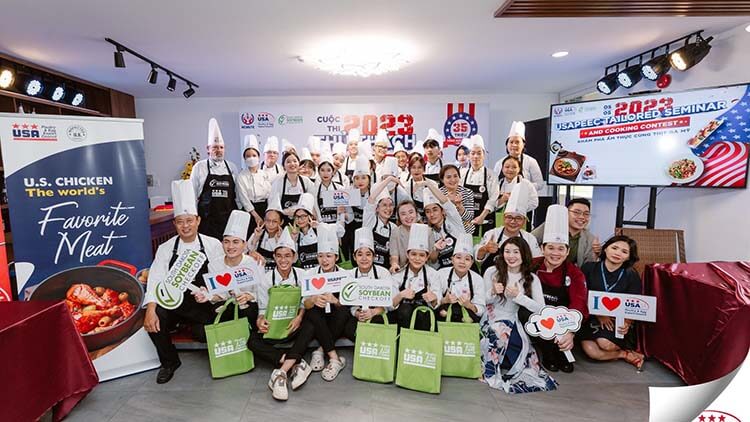 Reading Time: 5 minutes
Reading Time: 5 minutes
Poultry Export Council contributes to increased corn usage
Written by Jonathan Eisenthal
Above: A USAPEEC online/virtual chef workshop in Mexico, where participants prepared chicken dishes with chef Ruben Mora.
“We like to say that we fly corn and beans,” said Greg Tyler, president and CEO of the USA Poultry and Egg Export Council, or USAPEEC. He refers to the feed ration of broiler chickens, laying hens and turkeys, which consists almost entirely of corn and soybean meal.
USAPEEC counts on the partnership and support of corn and soybean producers, and the benefits to corn farmers and rural communities have been evident. It’s why Minnesota Corn is proud to invest corn check-off funds in USAPEEC and its efforts to expand exports of U.S. poultry and egg products.
Approximately one-third of feed corn goes into poultry and egg production, as well as 55-60 percent of soybean meal. The U.S. is the biggest producer of poultry and eggs, and in exports, it is second only to Brazil.
Tyler noted that even at the height of the HPAI outbreak (highly pathogenic avian influenza), American poultry producers managed to increase their production and exports. In 2022, the industry reached a record of $6.2 billion in exports.
With an annual 3-4 percent growth in poultry and egg production, America is steadily gaining ground against Brazil, which stands to benefit the entire agricultural industry.
“That goes to show that our industry is very committed to expanding internationally and to making sure that we are making available high-quality, low-cost protein to markets around the globe,” Tyler said.

Worldwide presence
USAPEEC has 16 offices and consultants in key markets, a staff of 14 at its Atlanta home office, and another 35 people around the globe bringing USAPEEC programs to 75 countries worldwide.
“Our goal is to make sure that we are on top of trade policy and technical issues so that we can keep our products flowing into these overseas markets,” Tyler said. “We also have the marketing side of the organization, too, so we carry out a number of activities, and it just depends on the particular market as to how diverse those programs are.”
One key activity is chef training and work with food service companies to encourage the incorporation of American poultry and eggs into their menus.
“India is a prime example,” Tyler said, noting that India is now the most populous nation on earth. “We gained access to the market in India in 2018, and one of the areas that we focused on there is the food service area. They have a number of chefs around that large country, but it’s hard to reach them all because it is such a big market. During the pandemic, we were doing virtual trainings. Normally, we would have 40 chefs in a training room. With the virtual events, we were able to train over 600 chefs in a single session. That helped expand our reach. We are trying to come up with creative ways to reach the food service area.”
USAPEEC has also invested significantly in developing poultry exports to Mexico, which Tyler said is one of the organization’s biggest success stories.
“We have been working with their poultry industry for a long time,” he said. “Their industry has grown. Our exports to Mexico have continued to grow. It’s our largest export market. And they are exporting as well. We try to make sure that before we go into a market, that if they have a major poultry production market, we are going to meet with their poultry producers and make sure that they know that we are not going to put them out of business.”
Another market poised for major growth in U.S. poultry and egg exports is Africa.
“Over the past 20 years, it has grown from a $60 million market to a roughly $640 million market,” Tyler reported. “We are exporting to 33 countries on the continent of Africa. It is a good opportunity for us, because what they are looking for are low-cost, high-quality protein sources. That’s a natural fit for our industry.”

Developing the ‘cold chain’
The key to continued growth in markets in both developing and first world countries is transportation and reinforcing the robustness of the ‘cold chain,’ as the industry refers to the system of transporting frozen and chilled product.
“We work with the Global Cold Chain Alliance in a number of markets,” Tyler said. “We do training with wholesalers to make sure they are properly storing and distributing the product, because the last thing we want is a sick consumer, due to the product being spoiled when it got to them. The transportation side is very important to us. With 120 countries around the world purchasing from us (the U.S.), you can imagine what kind of networks there are out there, just to get the products to the market. A lot of the products come into port, especially in areas like Sub-Saharan Africa or Central Asia, and then they are trans-shipped (reloaded into new shipping vessels) into other countries.”
One of the effects of the pandemic was that people became extremely concerned with ensuring their pantries were stocked with meat products, and this led to an expansion of refrigeration, both in wholesale and retail stores, and even in many homes in the developing world.
Maintaining markets for turkey
Thinking in particular about Minnesota, and its position at the top of U.S. turkey production, Tyler noted that USAPEEC supports the export of turkey meat as well.
“U.S. turkey production has been hit by avian influenza, but we are seeing increases in production and export markets are critical,” Tyler said. “Mexico in particular takes about 70 percent of the U.S. industry’s exports. We work very closely with Mexican meat processors to incorporate turkey into their product mixes. From a turkey standpoint, the turkey industry has at one time reached 14 percent of their production being exported. Because of HPAI, not just recently, but since 2015, that has decreased exports down to between 8-9 percent of production. But it is still a very vital part of their industry’s success. It is something we work very hard on, to diversify export markets for the turkey industry, so that we can continue to expand production and exports of U.S. turkey meat.”
With a growing world population, and growing demand for high-quality, low-cost protein, poultry and egg markets will continue to expand for the foreseeable future and USAPEEC will be there to help U.S. producers take part in that growth.

